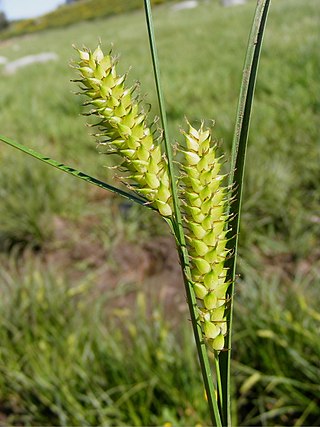
Carex vesicaria is an essentially Holarctic species of sedge known as bladder sedge, inflated sedge, and blister sedge. It has been used to insulate footwear in Norway and among the Sami people, and for basketry in North America.

Carex pensylvanica is a species of flowering plant in the sedge family commonly called Pennsylvania sedge. Other common names include early sedge, common oak sedge, and yellow sedge.

Carex lacustris, known as lake sedge, is a tufted grass-like perennial of the sedge family (Cyperaceae), native to southern Canada and the northern United States. C. lacustris us an herbaceous surface-piercing plant that grows in water up to 50 cm (1.6 ft) deep, and grows 50–150 cm (1.6–4.9 ft) tall. It grows well in marshes and swampy woods of the boreal forest, along river and lake shores, in ditches, marshes, swamps, and other wetland habitat. It grows on muck, sedge peat, wet sand or silt, in filtered or full sunlight.

Carex aggregata is a species of sedge that was first described by Kenneth Mackenzie in 1910. It is native to the eastern United States and Canada.

Carex arctata, known as drooping woodland sedge, is a species of sedge native to eastern North America. It is sometimes called black sedge, compressed sedge, or drooping wood sedge. It occurs from Manitoba to the Maritimes in Canada, south to northwestern North Carolina, and west to Minnesota. Carex arctata grows in bogs, hardwood forests, and spruce forests.
Carex arctiformis, the polar sedge, is a species of sedge native to sphagnum bogs and other wetlands in northwestern North America.
Carex biltmoreana, known as Biltmore sedge, is a species of sedge that was first described by Kenneth Mackenzie in 1910. It is endemic to the southeastern United States, where it occurs in southwestern North Carolina, northwestern South Carolina, and northeastern Georgia. Biltmore sedge grows on rock outcrops, often on granite, and in adjacent woodlands.
Carex bulbostylis, known as the false hair sedge, is a species of sedge native to the southcentral and southeastern United States. It was first formally named by Kenneth Mackenzie in 1915. It is also known as the eastern narrowleaf sedge, thick style sedge, and globose sedge.
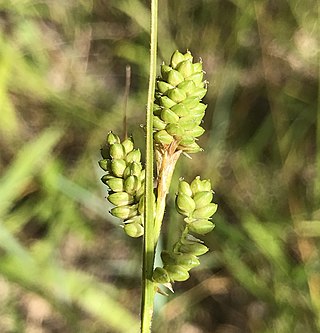
Carex hirsutella, the hairy green sedge or fuzzy wuzzy sedge, is a species of North American sedge that was first described by Kenneth Mackenzie in 1923. It ranges from Texas, throughout most of the central and eastern United States, north to Ontario and Quebec.
Carex merritt-fernaldii, or Fernald's sedge, is a species of sedge from northeastern North America. It was first described by Kenneth Mackenzie in 1923. It is named after botanist Merritt Fernald.
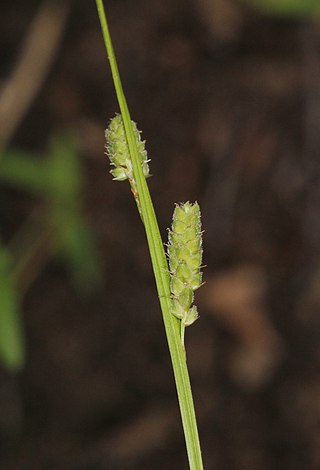
Carex swanii, known as Swan's sedge or downy green sedge, is a species of flowering plant in the family Cyperaceae. It is native to eastern North America.
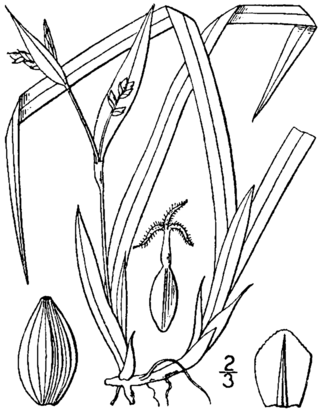
Carex abscondita, the thicket sedge, is a North American species of sedge first described by Kenneth Mackenzie in 1910. It grows along the central and eastern United States, from eastern Texas to southern Missouri, east to the Atlantic coast, and north to New Hampshire. It grows in moist areas of forests, shrublands, and swamps.

Carex flexuosa, commonly called flexuous white-edge sedge, or Rudge's white-edge sedge, is a species of flowering plant in the sedge family, Cyperaceae. It is native to the eastern North America, where it is found in eastern Canada, the northeastern and midwestern United States, and southward in the Appalachian Mountains. Its natural habitat is in upland forests, rock outcrops, and Appalachian balds. It is typically found in areas with acidic soil.
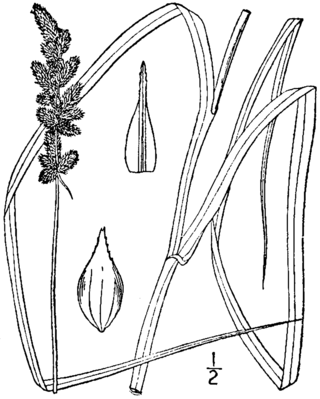
Carex annectens, sometimes called yellow-fruited fox sedge, is a species of sedge native to most of the eastern United States and southeastern Canada. It is common in prairies and high-water table fallow fields. In the Chicago area, its coefficient of conservatism is 3, and in Michigan, it is only 1, indicating its relatively low fidelity to high quality habitats.

Carex juniperorum, the juniper sedge, is a perennial flowering plant native to North America, first described by botanist William J. Crins in 1993. C. juniperorum is in the Cyperaceae (sedge) family, and is closely related to C. jamesii and C. willdenowii. It is commonly called juniper sedge as it is often seen growing in areas with red cedar, though the presence of cedar is not necessarily a requirement for it to grow.

Carex lupulina, known as hop sedge or common hop sedge, is a species of sedge native to most of eastern North America.
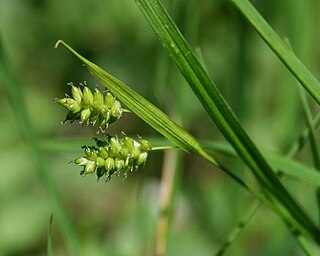
Carex pallescens, called pale sedge, is a widespread species of flowering plant in the genus Carex, native to the northeastern United States, eastern Canada, Iceland, Europe, Tunisia, and western Asia. It has unstable chromosome numbers.
Carex deweyanaDewey's sedge, short-scale sedge, is a species of sedge native to Canada and the United States.
Carex peckii, Peck's sedge, Peck's oak sedge, or white-tinged sedge, is a species of sedge native to Canada and the United States.













